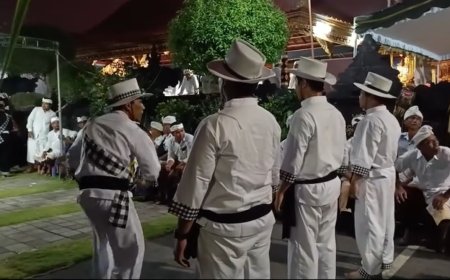Poleng Kesiman: Sacred dance performed during the Ngerebong Ceremony in Kesiman Village.

Kesiman Village, located in the eastern part of Denpasar City, has a very interesting art and culture. An example is the Ngerebong Ceremony in which there are various interesting and distinctive cultural events. One of them is the existence of Poleng Kesiman dance. The dance tradition in Bali has more than 40 types of sacred Baris dance. Baris dance comes from the word baris which means row or leret which describes the courage of warriors who are ready to fight on the battlefield. It can be seen in its agile and energetic movements and the use of weapons as a performance property while adding to the impression of dashing for the dancer. After showing a very agile and energetic movement, the sacred line dancers will perform a memendet movement that is gentle and more contemplative. I Made Bandem in his book, Kaja and Kelod Balinese Dance in Transition reveals that the memendet dance is a dance performed by adult men from the temple congregation or sometimes by the pemangku himself. After completing the offerings, the pemangku then gave offerings in the form of arak berem to evil spirits. Furthermore, Soedarsono states that Baris is a male dance performed by groups of adult men that functions as a welcoming dance to the gods invited during odalan. Likewise, Poleng Kesiman dance is included in the Bebarisan dance category, precisely the Baris Pependetan dance. Judging from the dance movements and functions, Poleng Kesiman Dance is a form of warrior dance which generally functions as an army or soldiers guarding the gods who descended from heaven.

One of the characteristics of guardian dance is that it is not too concerned with the aesthetics of movement and choreography. That also applies to this Poleng Kesiman dance, where the dancers mostly use ngaed. And, the type of movement is similar to martial arts movements. This can be seen when the dancers are so agile in dancing the weapon properties they carry. Occasionally the dancers must need the help of others to calm themselves down when they can no longer control themselves. Many meaningful movements contained in this dance are performed by dancers in a trance, such as brandishing weapons up and in front of Pemangku Dalem (who oversees the dance performance from the door of the main courtyard of the temple mandala and is also in a trance). The movement signifies the dancers' readiness to fight and maintain the security of Kesiman village in the abstract. This is similar to the meaning of sacred line dance found in Bali in general.
According to the book "History of the Temple" from UNHI research in 2006, the Ngerebong ceremony is included in the Bhuta Yadnya category. The word Caru means beautiful or harmonious. So this aims to remind Hindus through the medium of sacred rituals to always maintain the harmony of human relations with humans, humans with nature, and humans with God. The "Ngerebong" procession is held every Redite Pon Medangsia or 18 days after Galungan. Poleng Kesiman dance is a form of guardian dance which in the past was believed to be the mainstay soldier of the King of Kesiman. The dance is danced in groups of 5 dancers. The properties carried by the dancers are various types of weapons such as Gada, Tombak, Parang, Shield and Keris. The condition of the dancers when dancing is in a trance or controlled by certain forces beyond human reason. Uniquely, in such a state, they do not scream hysterically like trance in general, but move to dance with full charisma.

At the time of the performance, the Kesiman Poleng dancers wore black long-sleeved shirts made of velvet cloth, wore white cloth, a poleng-colored saput, and a poleng-colored shawl wrapped around their bodies. And wears a destar (a type of headdress in the form of sheets of cloth folded in such a way) in poleng color as well. A red hibiscus flower is tucked into the dancer's ear and a kris is tucked into her waist. Here we can see that there is a similarity in the use and type of costume with Baris dance in general, which is very distinctive, especially in the conical headdress decorated with seashells. This shows one of the characteristics of Poleng Kesiman dance in terms of its costume.
The performance time begins when the female stakeholders called Sutri come out of the main door of the temple. They dance in a trance but not as hysterical as the first procession. By using all-white clothes and decorated with green and blue vests. After that, it is continued by carrying the sacred heirloom of Kesiman village in the form of a black and white belt (poleng) which is approximately 15 meters long. This belt is carried by several female stakeholders wearing all-white clothing. The belt is carried by several female stakeholders wearing all-white outfits, followed by four female stakeholders carrying clappers. Then followed by the pemangku who dance wearing all black and white clothes (poleng) and carrying various types of weapons. They are called the Poleng Kesiman rerencangan. Finally, Mangku Pura Dalem Kesiman, Mangku Gede Puri Kesiman, the Manca and Prasanak come out to watch the procession circling the wantilan three times counterclockwise. Afterwards, the dancing stakeholders return to the temple's innards.
This Kesiman Poleng Dance with the belief that it has existed for a long time, is an inseparable part of Bali's cultural wealth. It strengthens the identity and sustainability of the cultural heritage of the Kesiman community. Until now, this dance is still maintained and passed down from one generation to the next in Kesiman village. Thus, the Kesiman Poleng dance continues to be an important symbol in preserving tradition and enriching cultural life in Bali.






























































